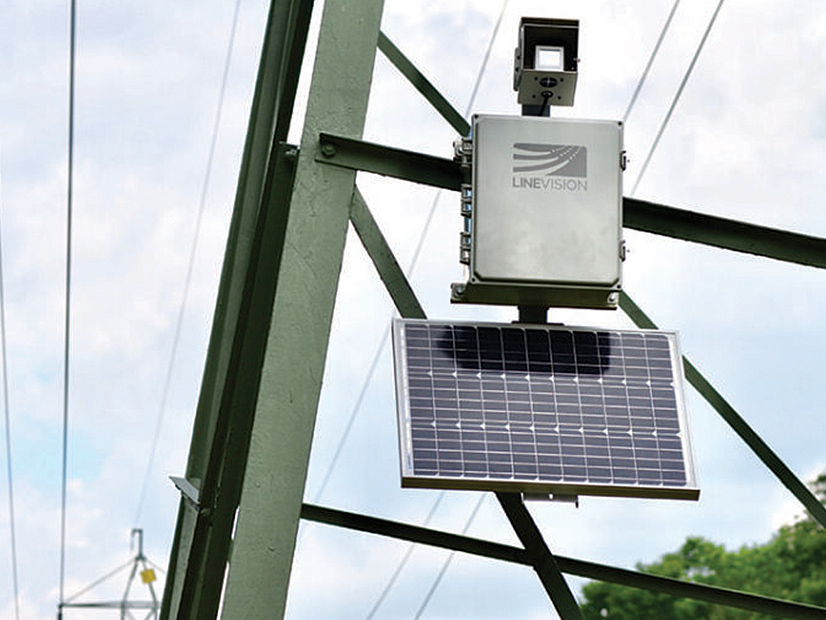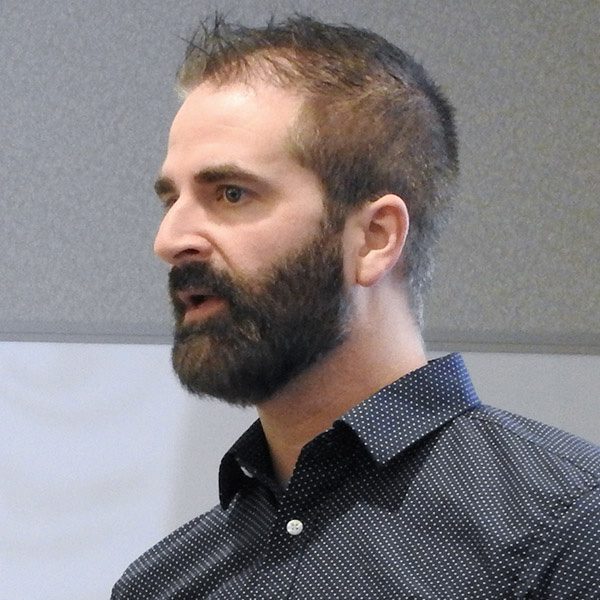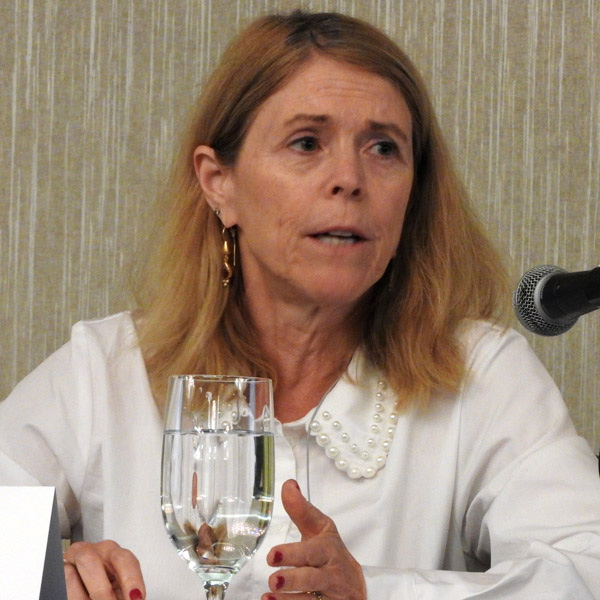
Illinois Energy Transition Act Update
PJM updated stakeholders at last week’s Operating Committee meeting regarding ongoing discussions with the Illinois Environmental Protection Agency over the impacts of the state’s sweeping energy legislation passed in September that has it on a 30-year path to 100% carbon-free electric generation.
 Chris Pilong, PJM | © RTO Insider LLC
Chris Pilong, PJM | © RTO Insider LLCChris Pilong, director of PJM’s operations planning department, provided an update on the Illinois Energy Transition Act and the RTO’s response. Signed into law on Sept. 15 by Gov. J.B. Pritzker, the legislation requires all investor-owned baseload coal-fired power plants and remaining oil peaker turbines to shut down by 2030. (See Illinois Senate Passes Landmark Energy Transition Act.)
Gas turbine plants, including ones currently under construction, must also close by 2045 under the terms of the bill, although the state has an option to allow continued operation if they are critically needed.
Pilong said the broad scope and impact of the legislation has created a need for generation owners and Illinois state entities to have discussions and resolve issues.
“We’re well aware that there’s still a number of unanswered questions that generator owners have with respect to the legislation,” Pilong said.
PJM has been focusing on and working with the Illinois EPA and other state agencies on language within the legislation permitting generators “out of run hours” in the near term if there’s a reliability need for the resources. Pilong said there’s not much detail in the legislation about what out-of-run hours mean, resulting in a “source of confusion” and questions about how it will be implemented.
PJM wants the EPA to “provide clarity” on the guidance for generators and to post the language publicly. Pilong said the RTO hasn’t drafted language yet on the issue to present to the EPA, but it plans on having draft language ready by the end of the month. He said PJM is focusing on five areas of reliability needs in the language, including capacity, thermal constraint control, reactive support, system restoration through black start resources and testing of resources.
The RTO has also performed some initial analysis to see if there were any concerns this winter with thermal or voltage constraints resulting from the implementation of the legislation, Pilong said, but it didn’t find any concerns. PJM is also looking at analysis of the medium- and long-term impacts of the legislation on generation.
Paul Sotkiewicz of E-Cubed Policy Associates said he had concerns PJM was “abdicating its reliability responsibility” in favor of the language in the Illinois legislation. Sotkiewicz said the Illinois EPA is not subject to oversight by FERC and NERC like PJM.
Pilong said the language PJM is working on with the EPA is meant to give generation owners “more confidence” that the RTO isn’t taking unilateral actions that will put them in conflict with the state legislation.
“We’re not looking to get the blessing from the state about how reliability is maintained,” Pilong said. “Illinois is well aware that’s PJM’s responsibility.”
Sotkiewicz asked if PJM is pushing Illinois to conduct a rulemaking process on the legislation, calling it “absolutely critical” to provide guidelines. He said PJM in the past has met with state staffs to explain what needs to be included in rulemakings to guarantee reliability in the RTO.
“You’ve been given the reliability needs, and a state could turn around and say, ‘No thank you,’ and you’re stuck with it,” Sotkiewicz said.
Stephen Bennett, PJM manager of regulatory and legislative affairs, said Sotkiewicz misunderstood. He said the Illinois EPA told PJM that the “omission of explicit language” authorizing rulemaking on the issue in the legislation was a “conscious choice” made by the legislature and that the agency “does not have the authority” to conduct a rulemaking process.
“PJM has been explicitly clear that PJM and our members need as much clarity as possible to allow for us to move forward with our No. 1 priority of managing reliability,” Bennett said.
 Marji Philips, LS Power | © RTO Insider LLC
Marji Philips, LS Power | © RTO Insider LLCMarji Philips, vice president of wholesale market policy at LS Power, said her company believes the Illinois legislation could result in a reversal of some of the “extraordinary gains” made on emission reductions in PJM. The company’s analysis shows more coal plants could end up operating in Illinois and in other states to make up for the loss of generation resources, she said.
She asked PJM to help identify some of the “environmental consequences” of the legislation on other states in the RTO through additional studies.
“When you turn off natural gas in Illinois, that might mean a whole lot more coal runs in Indiana or Ohio, actually defeating the whole purpose of the legislation,” Philips said.
Dynamic Line Rating Issue Delayed
PJM is delaying requirement language for several manuals related to the implementation of a dynamic line rating (DLR) system in the RTO after a FERC decision in December that ended static ratings.
Chris Callaghan, senior business solution engineer with PJM’s applied innovation department, had presented a first read of a problem statement and issue charge regarding DLR at last month’s OC meeting. (See “Dynamic Line Rating,” PJM Operating Committee Briefs: Dec. 2, 2021.) PJM is looking to install sensors on or near existing transmission lines to collect real-time data. The technologies include weather stations, electromagnetic field detectors and thermal cameras.
Later that month, FERC ordered transmission providers to employ ambient-adjusted ratings for short-term transmission requests and seasonal ratings for long-term service. (See FERC Orders End to Static Tx Line Ratings.)
Callaghan said PJM is now waiting until the committee’s February meeting to conduct a second first read of the proposed problem statement and issue charge as the RTO’s legal staff reviews the commission’s order.
“We want to make sure we have time to digest the order and make sure we fully understand it,” Callaghan said.
Renewable Dispatch Endorsed
Stakeholders unanimously endorsed an issue charge aimed at improving dispatch of renewable resources and increasing forward-looking visibility.
Darrell Frogg of PJM’s generation department reviewed the problem statement and issue charge that were first presented at last month’s OC meeting. (See “Renewable Dispatch First Read,” PJM Operating Committee Briefs: Dec. 2, 2021.)
Frogg said that as the number of renewable resources grows, manually managing dispatch becomes more difficult and leads to inconsistent performance.
“We’re in the middle of a significant transition in fuel mix with a large influx of new solar and wind projects,” Frogg said. “We want to get ahead of this now before the next significant wave of new renewable resources becomes commercial.”
Key work activities of the issue charge include reviewing education on existing renewable dispatch practices, with a goal of proposing solutions to enhance the overall renewable dispatch process.
Frogg said stakeholder suggestions led to PJM adding education on renewable dispatch performance statistics, and solutions and practices from other RTOs/ISOs.
PJM also added the tariff term “intermittent resources” to go along with the term “renewable dispatch” to better align with existing language in the RTO’s governing documents. Frogg said PJM wanted to keep the issue broad to include all renewable resources.
Work on the issue charge will take place in the OC beginning in February and is estimated to take six months.
Frogg said PJM was originally looking to pursue the CBIR (consensus-based issue resolution) Lite approach to develop a proposal, but the issue charge was changed to use the normal process after several stakeholders questioned the RTO at last month’s OC meeting.
Manual 38 Revisions Endorsed
Stakeholders unanimously endorsed minor revisions to Manual 38 as a part of a periodic review.
Liem Hoang of PJM reviewed the revisions after first presenting them at the December OC meeting. (See “Manual 38 Changes,” PJM Operating Committee Briefs: Dec. 2, 2021.)
Hoang said the minor changes include adding language stating that the Eastern Interconnection Reliability Assessment Group will conduct “assessments to identify key reliability issues and the risks and uncertainties affecting adequacy and security of the bulk power system in the Eastern Interconnection.”
Members will vote on final endorsement of the changes at the Markets and Reliability Committee meeting Jan. 26.

